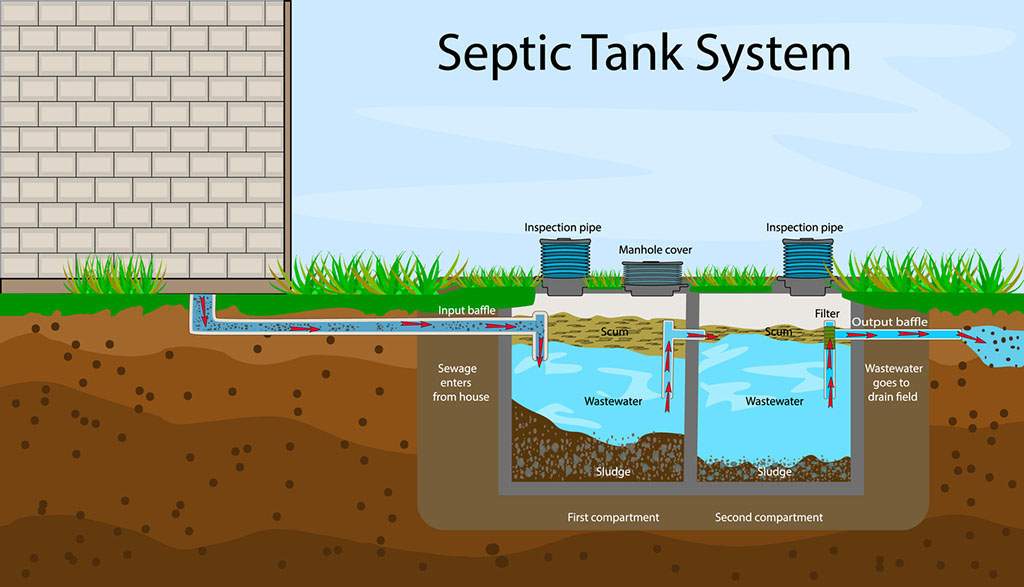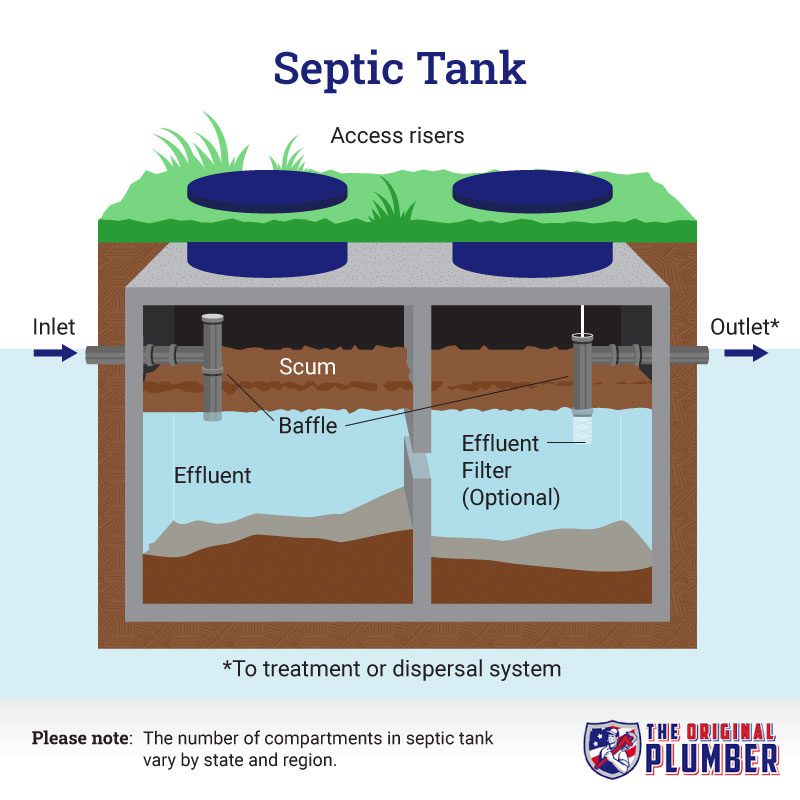how a septic tank operates
A septic tank is a large tank made of steel or concrete that is buried in the yard near the home. The tanks job is to protect your drain field or other components from becoming clogged by solids suspended in wastewater.

How Does A Septic System Work All Your Questions Answered
Household wastewater is flushed or washed through the exit pipe into the septic tank.

. An inlet and an outlet. Septic tanks work by allowing wastewater to sit and undergo a settling process. The illustration below shows a septic tank.
All water runs out of your house from one main drainage pipe into a septic tank. Rid-X Contains 100 Natural Active Bacteria And Enzymes. To summarize your septic tank is like your settling pond.
Lighter floatable solids such as grease oils and fats collect at the top of the liquid in the tank to form a scum layer. Over time bacteria eat away at this sludge and break it down into more manageable materials. A relatively clearer middle layer of liquid waste known as the effluent is left awaiting discharge to the drainfield.
Solid matter and sediment sink to the bottom of the septic system separating from the water. This water is then filtered into the area around it where it is fully cleaned. That means that non-water solid waste can build up unless it can be broken down and digested by bacteria while the remaining water simply and safely drains away elsewhere.
A holding tank for the wastewater. A conventional septic system will include a distribution box to help distribute the wastewater evenly among the trenches to ensure maximum wastewater to soil contact. Wastewater comes in from the home through the inlet is treated and heads out to the drain field via the outlet pipe.
There are basically two main pipes connecting to the septic tank. How a septic tank works is basic plumbing and biology. A typical septic tank will have two pipes on either side.
Specifically this is how a typical conventional septic system works. The tank is connected with two pipes for inlet and outlet. This means that wastewater from your sinks toilets showers.
Household wastewater enters the septic tank through the inlet. The drain field is a shallow covered pit in the soil that finishes wastewater treatment. Bacteria grows in the septic tank and digests the solids that are in the wastewater.
Gravity to move wastewater. A watertight buried septic tank allows solids to settle while oils and grease float to the top. Lighter solids such as grease oils and toilet tissue form the scum layer.
This also releases scum like fats greases and oil. Diagram of a septic tank. The tank is also fitted with inspection pipes which allow qualified plumbers to inspect critical parts of the septic tank design.
Safe For Pipes And Plumbing. Water runs out of your house to the septic tank. Heavy sold wastes settle down to the base of the tank forming the sludge layer while the lighter solids float up to form the scum layer.
All the drainage pipes from your home are connected to the septic tank which forms the septic system. Such waste matter includes wastewater and fecal matter. As seen in the septic tank diagram once the waste is sorted into its three main types the wastewater is then extracted from the tank through the outlet pipe for further treatment or disposal.
Septic tanks work by allowing waste to separate into three layers. The bacteria reduces the solids into liquid fats and grease and insoluble particles. What is a Septic System.
Heavy solids sink to the bottom. Septic tank holds the waste water. Compartments in the tank keep sludge in the.
A tank and a soil dispersal area or drainfield. How a Septic Tank Works. One enters from the house into the tank and transports all waste matter.
The septic system on your property includes two components. Settled solids form a bottom layer of sludge. How Septic Tank Works.
They can be quite large 2000-gallon capacity or more for residential usage. The middle layer of effluent exits the tank and travels through underground perforated pipes into the drainage field. Solids effluent and scum see illustration above.
What is a Septic Tank. The septic tank is a water-tight container that holds the waste water long enough to allow solids to settle down to the bottom sludge while the oil and grease float to the top scum. The inlet pipe collects the water waste in the septic tank long enough that the.
The main job of a septic tank is to clean dirty household water that comes from bathrooms laundry rooms and other areas of your home. Heavy solids settle to the bottom where bacterial action produces digested sludge and gases. The solids settle to the bottom where microorganisms decompose them.
The T-shaped outlet prevent the sludge and scum from leaving the tank and flowing into the drainfield. Over 24-48 hoursthe solids break down to form a sludge layer. The septic tank is a buried water-tight container usually made of concrete fiberglass or polyethylene.
The scum composed of waste thats lighter than water floats on top. Septic tank systems work by using. Ad Learn How Your Septic System Works Avoid Septic Backups With Rid-X.
Once wastewater enters the tank it is held there long enough for solid. A septic system and tank instead of letting all your waste flow down into the public sewers keeps all your flushables on-site. All of your household wastewater exits your home through a pipe to the septic tank.
The solids settle to the bottom where microorganisms decompose them. Wastewater from all plumbing fixtures drains into the septic tank. How Does a Septic System Works.
Heavier solids and decomposed waste fall to the bottom to form a sludge layer. The other pipe leading out of the septic tank leads to the drain field. All conventional septic systems have a septic tank which is usually a large buried rectangular or cylindrical container made of concrete fiberglass or polyethylene.
Solids effluent and scum see illustration above. Septic tanks work by allowing waste to separate into three layers.

How Septic Systems Work Aero Stream Llc Septic Tank Septic Tank Design Septic Tank Systems

How Does A Septic Tank Work Learn How Septic Systems Treat Wastewater

Septic Tanks Inspection Testing Maintenance Septic Tank Systems Septic Tank Diy Septic System

Understanding How Your Septic System Works Septic System Septic Tank Home Maintenance

How Does A Septic Tank Work Septic Tank Septic Tank Systems Septic System

What Is Septic Tank How Does A Septic Tank Work Septic Tank Design Based Per User Consumption Septic Tank Design Septic Tank Septic Tank Systems

How Does A Septic Tank Work Learn How Septic Systems Treat Wastewater

Septic Tank Maintenance A Guide For Homeowners Planta De Tratamiento De Aguas Residuales Tanque Septico Instalacion De Agua

Learn How A Septic System Works For Information Call Bonanza Septic 775 883 3411 Septic System Diy Septic System Septic Tank Systems

Septic System Basics Septic System Septic Tank System

How Living Off The Grid Works Septic Tank Systems Septic Tank Off The Grid

This Is A Picture Friendly Guide On What How Septic Systems Work How Often You Need Your Tank Pumped D Septic Tank Systems Septic System Septic System Service

Installing A Septic System The Country Life For Me Tratamiento De Aguas Casas Prefabricadas De Diseno Tanque Septico

What Is Septic Tank Types And How Does It Work Engineering Choice

What Is Septic Tank How A Septic Tank Works Construction Of Septic Tank Civilcrawl

How A Septic Tank Works Septic Tank Systems Septic Tank Septic Tank Design

What Is Septic Tank How Does A Septic Tank Work Septic Tank Design Based Per User Consumption Septik Dlya Doma Vodosnabzhenie

How Does A Septic Tank Work Septic Tank Septic Tank Design Septic Tank Systems

Septic Tank Diagram Google Search Septic Tank Design Septic Tank Septic Tank Systems